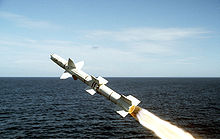Anti-aircraft warfare
By the late 1930s the British definition was "that height at which a directly approaching target at 400 mph [640 km/h] can be engaged for 20 seconds before the gun reaches 70 degrees elevation".Initially sensors were optical and acoustic devices developed during World War I and continued into the 1930s,[9] but were quickly superseded by radar, which in turn was supplemented by optoelectronics in the 1980s.Their use is assisted but not governed by identification friend or foe (IFF) electronic devices originally introduced during the Second World War.Targets are not always easy to destroy; nonetheless, damaged aircraft may be forced to abort their mission and, even if they manage to return and land in friendly territory, may be out of action for days or permanently.The most extreme case was the Soviet Union and this model may still be followed in some countries: it was a separate service, on a par with the army, navy, or air force.It remained in service throughout the war but 18-pdr guns were lined down to take the 13-pdr shell with a larger cartridge producing the 13-pr QF 9 cwt and these proved much more satisfactory.The British Wilson-Dalby gun director used a pair of trackers and mechanical tachymetry; the operator entered the fuse length, and deflection angles were read from the instruments.World War I demonstrated that aircraft could be an important part of the battlefield, but in some nations it was the prospect of strategic air attack that was the main issue, presenting both a threat and an opportunity.In the late 1930s the 10.5 cm FlaK 38 appeared, soon followed by the 39; this was designed primarily for static sites but had a mobile mounting, and the unit had 220 V 24 kW generators.Until this time the British, at RAF insistence, continued their use of World War I machine guns, and introduced twin MG mountings for AAAD.However, while the shell was a bit light (well under 2 lbs) it had a good effective ceiling and fired 125 rounds per minute; an AA carriage was developed and it entered service in 1939 as the 37 mm gun M1.A two-inch rocket using HE or wire obstacle warheads – the Z Battery – was introduced first to deal with low-level or dive bombing attacks on smaller targets such as airfields.The United States was still emerging from the effects of the Great Depression and funds for the military had been sparse to the degree that 50% of shells used were still powder fused.Fixed AA defences, using HAA and LAA, were established by the Army in key overseas places, notably Malta, Suez Canal and Singapore.Germany's high-altitude needs were originally going to be filled by a 75 mm gun from Krupp, designed in collaboration with their Swedish counterpart Bofors, but the specifications were later amended to require much higher performance.3″/50 caliber guns (Marks 10, 17, 18, and 20) first entered service in 1915 as a refit to USS Texas (BB-35), and were subsequently mounted on many types of ships as the need for anti-aircraft protection was recognized.[65] The Germans developed massive reinforced-concrete blockhouses, some more than six stories high, which were known as Hochbunker 'high bunkers' or "Flaktürme" flak towers, on which they placed anti-aircraft artillery.The 419th and 601st anti-aircraft gun battalions of the US Army were first allocated to the Folkestone-Dover coast to defend London, and then moved to Belgium to become part of the "Antwerp X" project coordinated from the Le Grand Veneur [nl][66] in Keerbergen.[67][68] Post-war analysis demonstrated that even with newest anti-aircraft systems employed by both sides, the vast majority of bombers reached their targets successfully, on the order of 90%.By 1955, the US military deemed the 40 mm Bofors obsolete due to its reduced capability to shoot down jet powered aircraft, and turned to SAM development, with the Nike Ajax and the RSD-58.In the 1982 Falklands War, the Argentine armed forces deployed the newest west European weapons including the 35 mm Oerlikon GDF-002 twin cannon and Roland missile.The shells fired by these weapons are usually fitted with different types of fuses (barometric, time-delay, or proximity) to explode close to the airborne target, releasing a shower of fast metal fragments.For shorter-range work, a lighter weapon with a higher rate of fire is required, to increase a hit probability on a fast airborne target.Invariably the type is differentiated from other fighter aircraft designs by higher speeds and shorter operating ranges, as well as much reduced ordnance payloads.In their functional roles they provide target search, threat detection, guidance, reconnaissance, navigation, instrumentation, and weather reporting support to combat operations.A variety of designs have been developed, using lasers,[74] net-guns and air-to-air netting, signal jamming, and hi-jacking by means of in-flight hacking.[76][77] Alternative approaches for dealing with UAVs have included using a shotgun at close range, and for smaller drones, training eagles to snatch them from the air.The ALKA directed-energy weapon (DEW) system is a Turkish dual electromagnetic/laser weapon developed by Roketsan allegedly used to destroy one of GNC's Wing Loong II UAVs; if true, this would represent the first known time a vehicle mounted combat laser was used to destroy another combat vehicle during genuine wartime conditions.However, most air forces choose to augment airbase defence with surface-to-air missile systems as they are such valuable targets and subject to attack by enemy aircraft.In Somalia, militia members sometimes welded a steel plate onto the exhaust end of an RPG's tube to deflect pressure away from the shooter when shooting up at US helicopters.


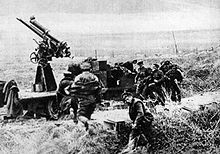






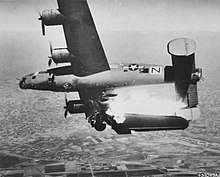


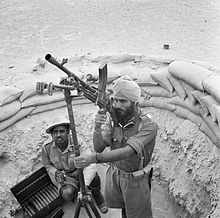


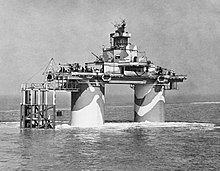





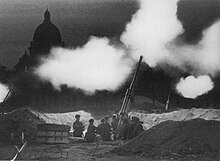



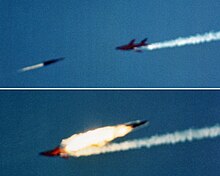



Surface-to-air missileFlak (disambiguation)Ack Ack (disambiguation)Anti-Aircraft (video game)Joint Ground-based Air Defence CommandoutlineHistoryPrehistoricAncientPost-classicalCastlesEarly modernMilitary revolutionPike and shotNapoleonic warfareLate modernIndustrial warfareFourth-gen warfareMilitaryOrganizationCommand and controlDefense ministryAir forceMarinesCoast guardSpace forceReservesEngineersMedicalPoliceDivingInfantryCavalryArtillerySpecial forcesSignal corpsWarshipsSubmarinesAircraft carriersLanding craftAuxiliary shipsFightersBombersCommandClose air supportElectronic-warfareReconnaissanceFire-control systemFire-control radarDirector (military)Combat information centerShip gun fire-controlGun data computerTorpedo data computerBasic trainingMilitary manoeuvrersCombat trainingBattlespaceAerospaceAerialAirborneCold-regionDesertFortificationJungleMountainSubterraneanTunnelAmphibiousSurfaceUnderwaterSeabedInformationWeaponsBarrageBiologicalCamouflageHorsesChemicalCombined armsConventionalDenialDisinformationElectromagneticLoiteringMissileNuclearPsychologicalRadiologicalSubmarineUnconventionalTacticsList of military tacticsAirliftAir assaultAirbridgeAirdropAnti-subAnti-tankBattleChargeCounterattackCounterinsurgencyConvoyDefeat in detailFoxholeEnvelopmentFormationGuerrillaRapid dominanceEncirclementInvestmentScreenTactical objectiveTarget saturationTrenchWithdrawalOperationalMilitary operationSpecialOperations researchBlitzkriegExpeditionaryDeep operationManeuverOperational manoeuvre group
